Child Nutrition in Bangladesh

icddr,b, in collaboration with The Daily Star, organised a roundtable titled "Child Nutrition in Bangladesh" on April 22, 2025. Below is a summary of the discussion.
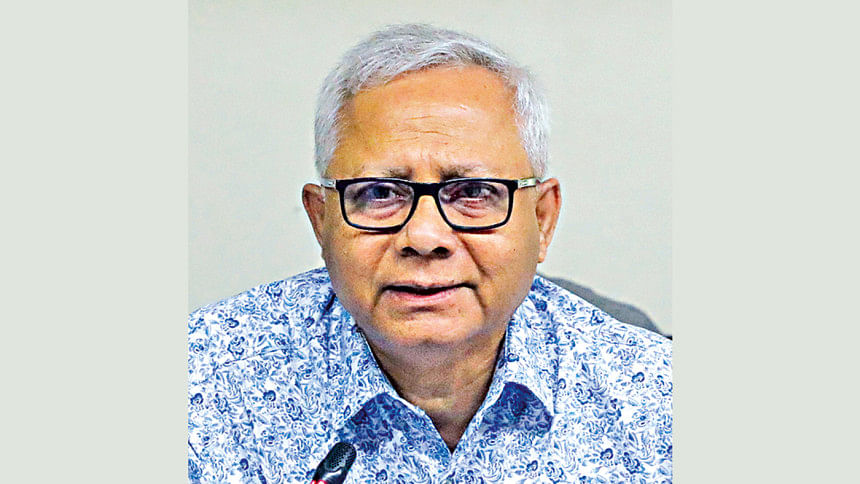
Dr Tahmeed Ahmed, Executive Director, icddr,b
(Keynote Presentation)
Despite frequent discussions on climate change and development, we often overlook a pressing issue in Bangladesh and similar countries: nutrition. A recent visit to a wet kitchen market revealed soaring prices of protein staples such as tilapia, pangas fish, eggs, milk, and meat, highlighting concerns about childhood nutrition.
Stunting is a classic indicator of chronic undernutrition and is associated with increased vulnerability to infections such as diarrhoea and pneumonia, as well as a higher risk of mortality.
Stunted children also tend to respond poorly to oral vaccines, including those for cholera and rotavirus. Their brain development is also severely affected, leading to reduced cognitive ability and productivity later in life.
Achieving the Sustainable Development Goals (SDGs), particularly Goal 2—ending hunger and improving nutrition—requires addressing critical targets such as stunting, anaemia, low birth weight, breastfeeding, and wasting.
While Bangladesh's exclusive breastfeeding rate is around 55%, indicating some progress, many infants still miss out on the vital nutrition that breast milk provides. The goal is to increase this rate by 50% in the first six months, which demands further efforts.
Stunting among children under five declined from 41% to 24% between 2011 and 2022, yet one in four children remains stunted. The target is to reduce this by 40%, although current trends suggest Bangladesh is unlikely to meet this goal.
Underweight rates fell from 36% to 22%, and wasting from 16% to 8%, although wasting rose again to 11% by 2022. Some studies suggest it could be as high as 18%, nearing emergency thresholds set by WHO. These statistics underscore the urgency of addressing childhood malnutrition in Bangladesh.
While medical training traditionally taught that malnutrition begins after breastfeeding ends (around six months), a 2023 Nature study analysing data from 52,000 children across multiple countries, including Bangladesh, showed that the highest rates of stunting occur between birth and three months.
The study also demonstrated a link between national health expenditure and stunting: where only 1–3% of the health budget is allocated to nutrition, stunting rates can reach 35%. A decade ago, Bangladesh allocated only about 1% of GDP and 9–10% of its health budget to nutrition. Current figures are unavailable.
To understand stunting better, icddr,b collaborated with researchers from seven countries. Our analysis showed that birth size was the strongest predictor: low birth weight doubles the risk of stunting.
Maternal height—reflecting long-term maternal nutrition—was another key factor. Compromised maternal nutrition contributes to a two- to threefold increased risk of child malnutrition.
These findings emphasise the vital importance of the first 1,000 days—from conception to two years—for preventing malnutrition. Malnutrition during this period increases the risk of cognitive impairment.
Water, sanitation, and hygiene (WASH) are also critical. In unsanitary environments, infants ingest harmful bacteria that colonise the small intestine, causing environmental enteric dysfunction (EED), which contributes to stunting and poor efficacy of oral vaccines.
Addressing childhood malnutrition requires a comprehensive, sustained approach. First, increasing budgetary allocation is essential; without it, efforts will remain ineffective. Strengthening grassroots community health workers, ensuring adolescent girls' health and nutrition, promoting dietary diversity, and providing weekly iron and folic acid supplements are also vital.
Initiatives like mothers' clubs can provide peer support on issues such as breastfeeding, complementary feeding, and maternal mental health—particularly important as maternal depression has been strongly linked to childhood malnutrition.

Dr Md Mehedi Hasan, Assistant Director, Institute of Public Health Nutrition (IPHN)
Exclusive breastfeeding from birth up to six months is crucial for child nutrition, as breast milk contains all the necessary nutrients. In Bangladesh, exclusive breastfeeding increased to 65% in 2017–18. The latest data from 2022 shows it declined to 53%.
Challenges arise as many new mothers are garment workers who, after two to three months, must switch to formula due to limited maternity leave. Misconceptions that breast milk is insufficient—fueled by advertising and peer influence—also lower exclusive breastfeeding rates.
Improper formula preparation further worsens nutrition. To address this, every mother visiting gynaecologists at primary and tertiary hospitals should receive counselling, alongside widespread awareness campaigns. Functional breastfeeding corners in garment factories must also be ensured.

Prof Dr Chowdhury Ali Kawser, Retired Professor of Paediatrics, Bangabandhu Sheikh Mujib Medical University (BSMMU)
Exclusive breastfeeding followed by complementary feeding are essential. Complementary feeding involves continuing breastfeeding while introducing additional foods, yet proper practices are often lacking.
One major gap is the insufficient use of oil. While vegetables and fruits are encouraged, the importance of adding enough oil for adequate caloric intake is often overlooked. Mothers may practise complementary feeding but add too little oil, leading to inadequate nutrition.
Another issue is feeding frequency. Often, complementary feeding unintentionally becomes replacement feeding, with mothers discontinuing breastfeeding after introducing solid foods. It is crucial to emphasise that breastfeeding must continue alongside complementary feeding for the practice to be effective.
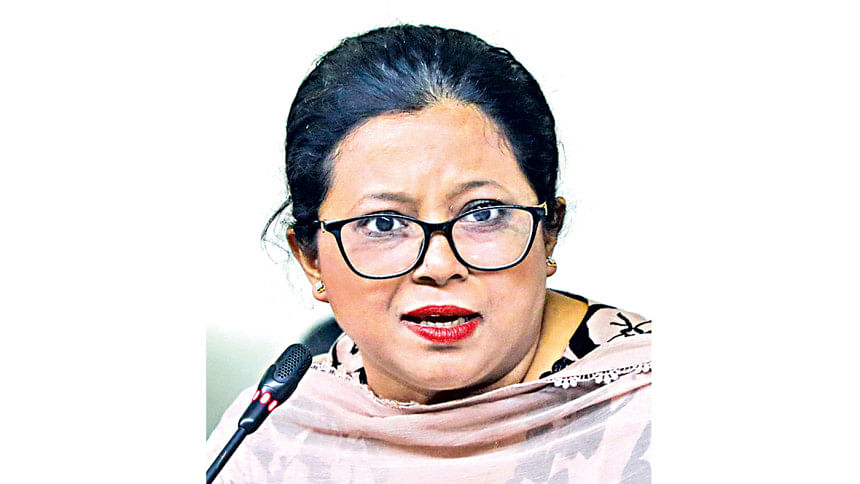
Dr Fahmida Sharmin Joty, Associate Professor, Obstetrics and Gynaecology, Bangladesh Medical College
Starting iron–folic acid supplementation for adolescent girls—similar to TT and MR vaccine campaigns—could significantly improve future maternal and child health. With high rates of underage marriage, strengthening girls' nutrition early would lead to healthier pregnancies and babies.
Current advocacy around multiple micronutrient supplementation (MMNS) highlights the need to begin interventions early to lower rates of low birth weight. Although 41% of the target population currently receives advice, many remain unreached.
Increasing the number of field workers and health assistants could help reduce stunting, preterm births, anaemia, and other related issues. Incorporating nutrition education into school and college curricula could create long-term change, promoting healthier mothers and babies for future generations.

Dr Farzana Rahman, Deputy Director, Bangladesh National Nutrition Council (BNNC)
BNNC is the highest authority for nutrition management, providing policy, technical, and administrative support across 22 ministries, with efforts underway to include more.
Childhood nutrition is a major focus in our national policies and BNNC is responsible for implementing these plans, especially during the first 1,000 days to prevent long-term malnutrition.
Recent initiatives include research in four coastal districts to develop child profile estimates and a costing model, surveying 934 mothers and caregivers. These tools will help expand interventions to other regions.

A.T.M. Saiful Islam, Additional Secretary (Public Health Wing), Ministry of Health and Family Welfare
Nutrition is fundamental to life and national development. A malnourished individual cannot contribute to growth or GDP, which is why the slogan "Enforce Nutrition for Growth" is significant.
Nutrition begins in the mother's womb, influencing brain development and lifelong health. Without proper prenatal care, achieving national nutrition goals is impossible. Nutrition is a multi-dimensional, multi-sectoral issue, requiring collaboration across ministries.
In Bangladesh, 22 ministries and many agencies are involved in improving nutrition. Farmers play a key role—nutrition is affected at every stage, from land selection and cultivation to food processing and storage, where nutritional value can either improve or decline.
Water, sanitation, and hygiene are deeply intertwined with nutrition. Poor hygiene contributes to illnesses like diarrhoea, which drain essential nutrients from children's bodies. Coordinated action between WASA and the Ministry of Local Government is essential to overcome these pressing challenges.
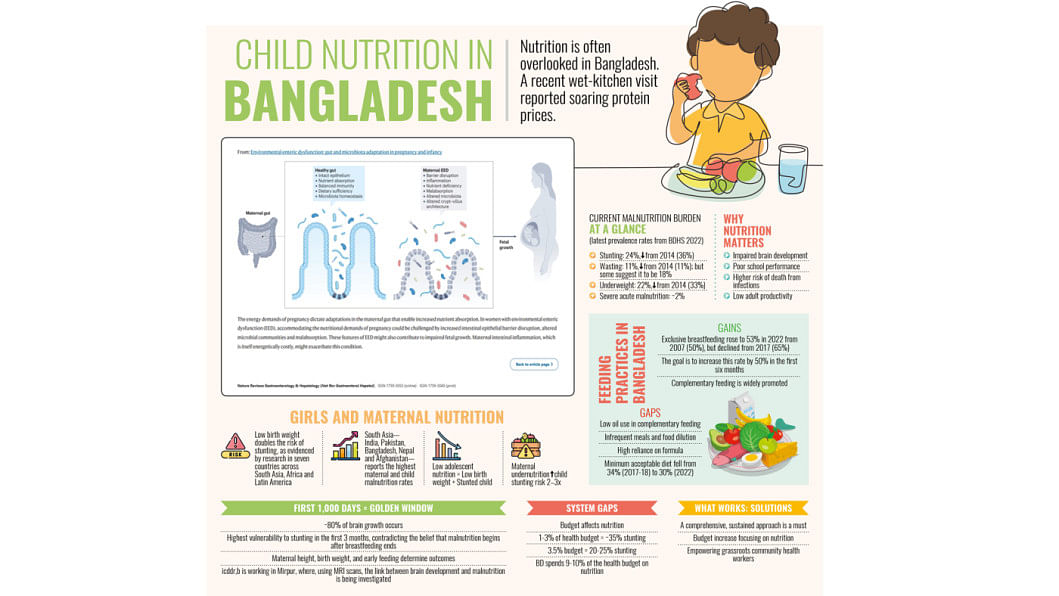

Prof. Salahuddin Mahmud, Professor of Paediatric Gastroenterology, Bangladesh Shishu Hospital & Institute
I would like to present a commonly experienced scenario to illustrate child nutrition challenges in Bangladesh. Aizuddin's malnourished grandson, Karimuddin, was taken to Dhaka after local treatment failed. The mother, a teen garment worker, could not stay due to work.
Despite initial recovery, the child relapsed six months later due to poverty, maternal malnutrition, and a lack of family support. Though child nutrition corners exist locally, accessing them is difficult, with one nutrition worker responsible for 200 families.
Bangladesh has around 1.7 million moderate and 500,000 severe malnutrition cases. Without addressing poverty and family instability, children will continue to relapse. Exclusive breastfeeding for six months, followed by regular family meals, is vital.
Alarmingly, the rate of minimum acceptable diet has worsened, dropping from 31% in 2017 to 26% today. Similarly, the percentage of children meeting the minimum meal frequency has declined from 81% in 2017 to 61%. At the core, it is education and financial stability that make the most significant difference in addressing these issues.

Dr. Thaddaeus David May, Senior Director, Nutrition Research Division, icddr,b
It is crucial to highlight how children can remain happy, capable, and healthy with parental support, even in challenging conditions marked by low hygiene and inadequate nutrition. This reality is, in many ways, encouraging. The progress made so far has been remarkable.
Encouragingly, Bangladesh has made notable strides in tackling child malnutrition. In 2014, moderate stunting affected 36% of children—just 2.5% of the global burden—while severe stunting stood at 12%, accounting for only 1% globally.
While a complete solution remains a distant goal, the most effective step we can take at this point is to focus seriously on preventing malnutrition.
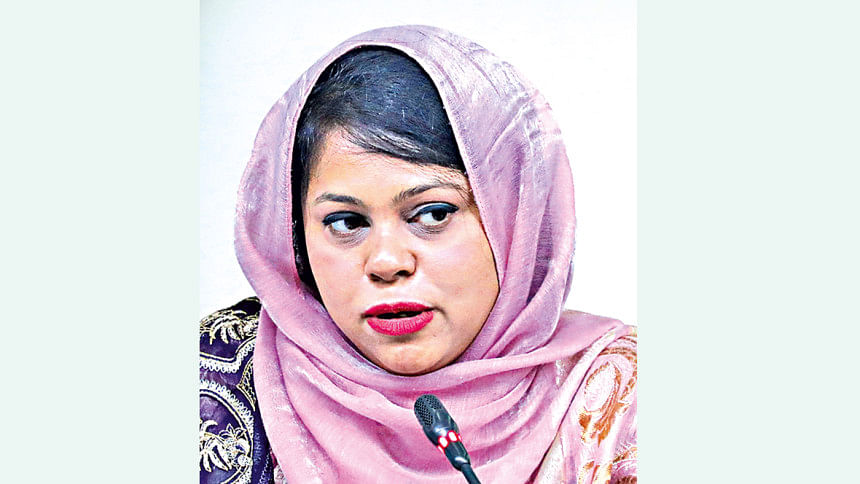
Samina Israt, Programme Officer – Diet-related Risk Factors, World Health Organization
Addressing the triple burden of malnutrition—wasting, stunting, and micronutrient deficiencies—alongside emerging challenges such as obesity and non-communicable diseases (NCDs), is critical.
Rapid urbanisation and poor dietary habits are key contributors, particularly among children and adolescents. Two major concerns are the lack of proper family meals and the rising consumption of junk food.
Balanced family meals rich in vegetables and meat are vital for cognitive development, physical growth, and immunity. In contrast, junk food—high in salt, sugar, and trans fats—leads to obesity, diabetes, cardiovascular issues, and premature death.
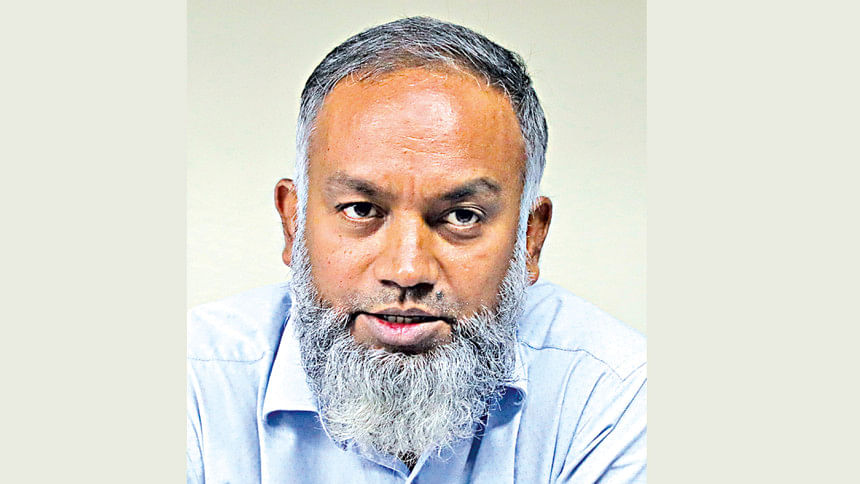
Dr. Muhammad Habibur Rahman, Line Director, Community-Based Health Care (CBHC), Directorate General of Health Services (DGHS)
Despite efforts by over 20 ministries and many organisations working on nutrition, the BDHS report does not show significant improvement in overall health performance from 2009 to 2024.
Across Bangladesh, 14,350 community clinics serve approximately 500,000 visitors daily, including over 100,000 children under five—constituting more than 20%. While we are committed to promoting health and nutrition, our facilities still offer only limited services.
The current three-month training period for service providers is inadequate to ensure quality care. To improve outreach and service delivery, we plan to expand our coverage to include all community clinics in the Sylhet and Chattogram divisions as a priority. Moreover, the work of the Food Safety Authority must be decentralised, particularly in light of findings of heavy metal contamination in food.
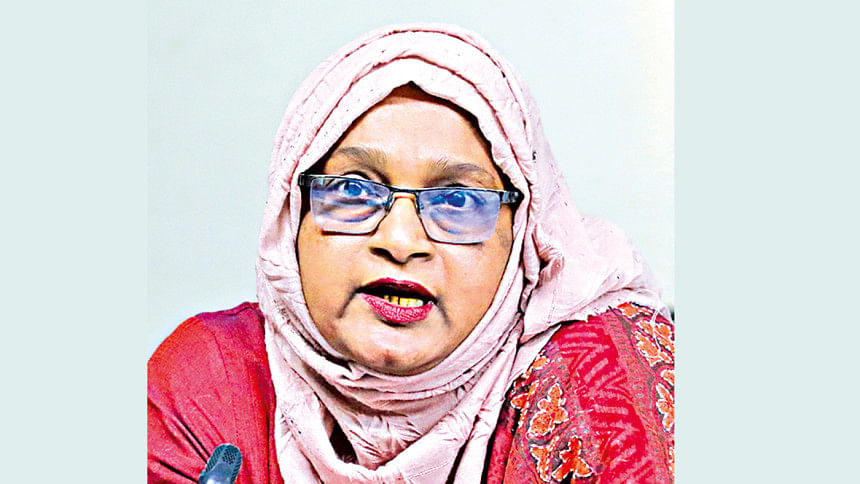
Prof. Dr. Anjuman Ara Sultana, Line Director, National Nutrition Services
To build a healthy nation, we must prioritise maternal and child nutrition, starting with adolescent girls at the SSC level. Since 2022, progress has stagnated, highlighting the need for increased budget allocations across all 64 districts.
Early child marriage, a major driver of poor maternal and child health, must be urgently addressed. Frequent childhood infections linked to underweight conditions reinforce the need for six months of exclusive breastfeeding.
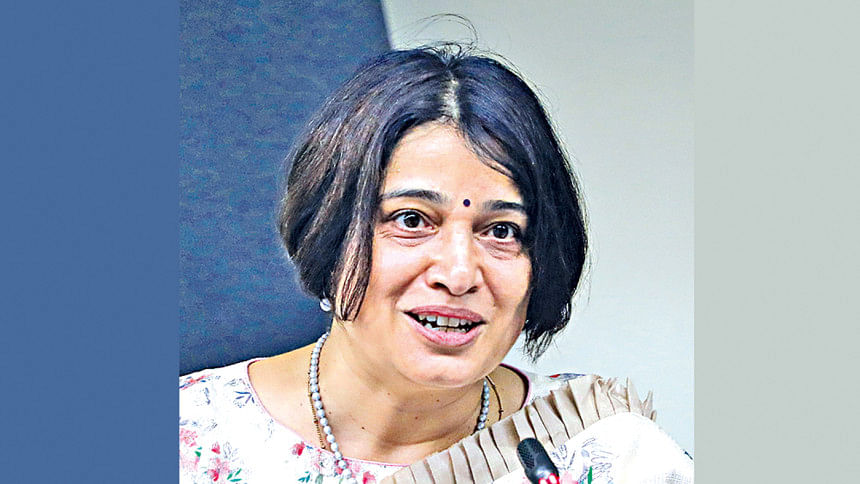
Deepika Mehrish Sharma, Chief of Nutrition, UNICEF
The Rohingya crisis offers a stark example of the challenges in delivering health and nutrition services during humanitarian emergencies. Bangladesh faces a critical situation, with child wasting rates ranging from 11% to 18%, and conditions in the Rohingya camps are even more alarming.
Approximately 500,000 children under five reside in the camps, receiving basic health, nutrition, and education services. Yet, between February 2024 and February 2025, severe wasting among these children rose by 27%, putting more lives at risk. Floods, diarrhoea, cholera outbreaks, and ration cuts have worsened their condition.
Addressing malnutriton requires a life-cycle approach that includes not only the health sector but also the private sector, policymakers, and ministries such as Public Health Engineering and Women and Children Affairs.
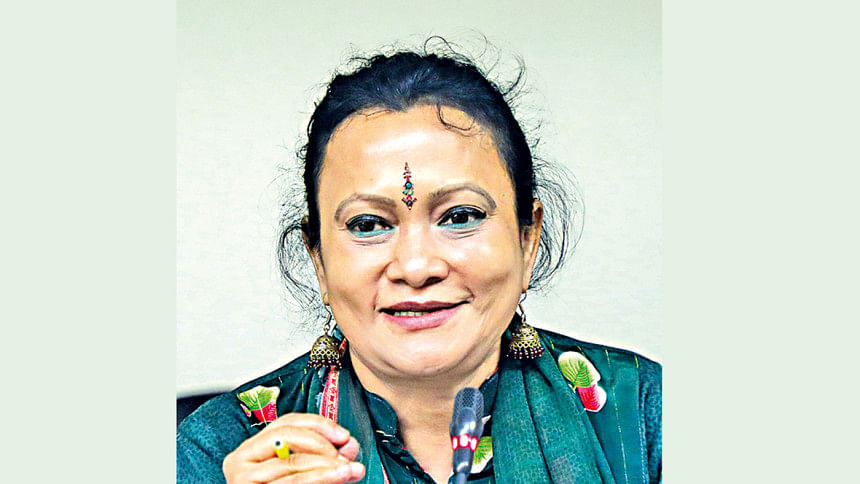
Dr. Rudaba Khondker, Country Director, Bangladesh, The Global Alliance for Improved Nutrition (GAIN)
As the proverb goes, "Give me a healthy mother, and I will give you a good and productive nation." This vision can only be realised by delivering comprehensive health and nutrition services to adolescents.
I would like to emphasise the urgent need to address affordability—specifically focusing on dietary diversity, dietary quality, and access to safe food. We must remain vigilant about what young people are consuming.
There is also growing discussion around establishing adolescent clubs, ensuring greater multi-sectoral involvement, and addressing household expenditure patterns. Scaling up evidence-based research is essential.

Dr. Abu Jamil Faisel, President-Elect, Public Health Association of Bangladesh
I would like to highlight several critical issues that directly affect the health and well-being of mothers and children.
Plastic consumption has become a growing concern. A recent Italian study revealed that individuals in South Asia consume an average of 11 kilograms of plastic annually, containing eight harmful components. This exposure poses serious long-term risks to children's health and development.
Lead poisoning and exposure to heavy metals demand urgent attention. The widespread use of pesticides and harmful agricultural chemicals has led to a rise in respiratory issues among children, compounding their existing vulnerabilities.
Addressing these environmental and health threats is essential to ensuring a safer, healthier future for our mothers and children.

Mahfuz Anam, Editor & Publisher, The Daily Star
We are honoured to be here with icddr,b, yet deeply saddened by how little we knew about the severe food and nutrition challenges faced by mothers and children—issues that lead to stunting and long-term harm. We are failing to nourish our children properly, and even when we do, food contamination remains a grave concern. As a society, we must do better.
The Daily Star is committed to publishing further investigative reports, following up on these critical issues, and using our editorial platform to bring them the attention they deserve. We stand firmly in support of this cause.

Tanjim Ferdous, In-Charge, NGOs & Foreign Missions, Business Development Section, The Daily Star & Moderator of the Session
Despite progress in health indicators, child nutrition in Bangladesh remains critical. The BDHS 2022 reports that 24% of children under five are stunted, 12% are wasted, and 22% are underweight, with around 370,000 suffering from severe acute malnutrition. Inequalities in nutrition, healthcare, and essential services persist—especially in slums and rural areas.
Recommendations
- Increase national budget allocations for nutrition, prioritising SDG Goal 2 indicators—stunting, anaemia, low birth weight, breastfeeding, and wasting.
- Promote exclusive breastfeeding for the first six months, and continue breastfeeding alongside complementary feeding thereafter.
- Counsel mothers at every stage—from conception to post-delivery—on nutrition, breastfeeding techniques, and dietary practices.
- Expand iron and folic acid supplementation for adolescent girls, similar to national vaccine campaigns, to improve future maternal and child health.
- Integrate nutrition education into school and college curricula to encourage healthy dietary habits from an early age.
- Establish and support mothers' clubs to provide peer guidance on breastfeeding, complementary feeding, and maternal mental health.
- Strengthen field-level health workforces, especially in underserved areas, by increasing the number of trained community health workers and assistants.
- Ensure the availability of functional breastfeeding corners in garment factories and other workplaces employing large numbers of women.
- Improve food safety monitoring by decentralising the Food Safety Authority and addressing contamination from pesticides, hormones, and heavy metals.
- Enforce the Breastmilk Substitutes Act more rigorously, and regulate marketing practices that discourage breastfeeding.
- Address environmental health threats like plastic ingestion, lead poisoning, and pesticide exposure that compromise maternal and child nutrition.
- Enhance multi-sectoral coordination between ministries (Health, Food, Women and Children Affairs, Local Government, etc.) for holistic nutrition programming.
- Strengthen WASH (Water, Sanitation, and Hygiene) interventions, particularly in slums and camps, to prevent malnutrition caused by enteric infections.
- Scale up Growth Monitoring and Promotion (GMP) sessions across health facilities and integrate overweight/obesity screening into routine services.
- Reduce reliance on donor-funded nutrition programmes by incorporating nutrition into long-term national development and political economy strategies.
- More grassroots-level community health workers are needed, who can assess children's nutritional status, provide counseling to mothers and family members, and take necessary actions to improve nutrition when needed.
- The habit of washing hands with soap needs to be improved, as it helps prevent enteropathy, which is directly linked to child undernutrition.
- Community-based management of severe malnutrition should be ensured.

 For all latest news, follow The Daily Star's Google News channel.
For all latest news, follow The Daily Star's Google News channel. 


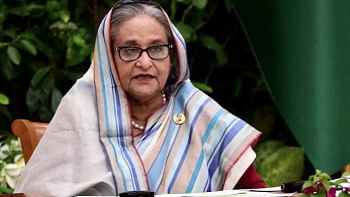
Comments